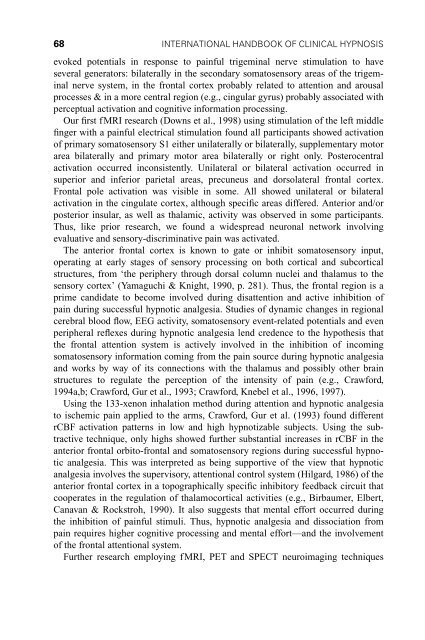International Handbook of Clinical Hypnosis - E-Lib FK UWKS
International Handbook of Clinical Hypnosis - E-Lib FK UWKS
International Handbook of Clinical Hypnosis - E-Lib FK UWKS
Create successful ePaper yourself
Turn your PDF publications into a flip-book with our unique Google optimized e-Paper software.
68 INTERNATIONAL HANDBOOK OF CLINICAL HYPNOSIS<br />
evoked potentials in response to painful trigeminal nerve stimulation to have<br />
several generators: bilaterally in the secondary somatosensory areas <strong>of</strong> the trigeminal<br />
nerve system, in the frontal cortex probably related to attention and arousal<br />
processes & in a more central region e.g., cingular gyrus) probably associated with<br />
perceptual activation and cognitive information processing.<br />
Our ®rst fMRI research Downs et al., 1998) using stimulation <strong>of</strong> the left middle<br />
®nger with a painful electrical stimulation found all participants showed activation<br />
<strong>of</strong> primary somatosensory S1 either unilaterally or bilaterally, supplementary motor<br />
area bilaterally and primary motor area bilaterally or right only.Posterocentral<br />
activation occurred inconsistently.Unilateral or bilateral activation occurred in<br />
superior and inferior parietal areas, precuneus and dorsolateral frontal cortex.<br />
Frontal pole activation was visible in some.All showed unilateral or bilateral<br />
activation in the cingulate cortex, although speci®c areas differed.Anterior and/or<br />
posterior insular, as well as thalamic, activity was observed in some participants.<br />
Thus, like prior research, we found a widespread neuronal network involving<br />
evaluative and sensory-discriminative pain was activated.<br />
The anterior frontal cortex is known to gate or inhibit somatosensory input,<br />
operating at early stages <strong>of</strong> sensory processing on both cortical and subcortical<br />
structures, from `the periphery through dorsal column nuclei and thalamus to the<br />
sensory cortex' Yamaguchi & Knight, 1990, p.281).Thus, the frontal region is a<br />
prime candidate to become involved during disattention and active inhibition <strong>of</strong><br />
pain during successful hypnotic analgesia.Studies <strong>of</strong> dynamic changes in regional<br />
cerebral blood ¯ow, EEG activity, somatosensory event-related potentials and even<br />
peripheral re¯exes during hypnotic analgesia lend credence to the hypothesis that<br />
the frontal attention system is actively involved in the inhibition <strong>of</strong> incoming<br />
somatosensory information coming from the pain source during hypnotic analgesia<br />
and works by way <strong>of</strong> its connections with the thalamus and possibly other brain<br />
structures to regulate the perception <strong>of</strong> the intensity <strong>of</strong> pain e.g., Crawford,<br />
1994a,b; Crawford, Gur et al., 1993; Crawford, Knebel et al., 1996, 1997).<br />
Using the 133-xenon inhalation method during attention and hypnotic analgesia<br />
to ischemic pain applied to the arms, Crawford, Gur et al.1993) found different<br />
rCBF activation patterns in low and high hypnotizable subjects.Using the subtractive<br />
technique, only highs showed further substantial increases in rCBF in the<br />
anterior frontal orbito-frontal and somatosensory regions during successful hypnotic<br />
analgesia.This was interpreted as being supportive <strong>of</strong> the view that hypnotic<br />
analgesia involves the supervisory, attentional control system Hilgard, 1986) <strong>of</strong> the<br />
anterior frontal cortex in a topographically speci®c inhibitory feedback circuit that<br />
cooperates in the regulation <strong>of</strong> thalamocortical activities e.g., Birbaumer, Elbert,<br />
Canavan & Rockstroh, 1990).It also suggests that mental effort occurred during<br />
the inhibition <strong>of</strong> painful stimuli.Thus, hypnotic analgesia and dissociation from<br />
pain requires higher cognitive processing and mental effortÐand the involvement<br />
<strong>of</strong> the frontal attentional system.<br />
Further research employing fMRI, PET and SPECT neuroimaging techniques











![SISTEM SENSORY [Compatibility Mode].pdf](https://img.yumpu.com/20667975/1/190x245/sistem-sensory-compatibility-modepdf.jpg?quality=85)





